Yoshimura history -23
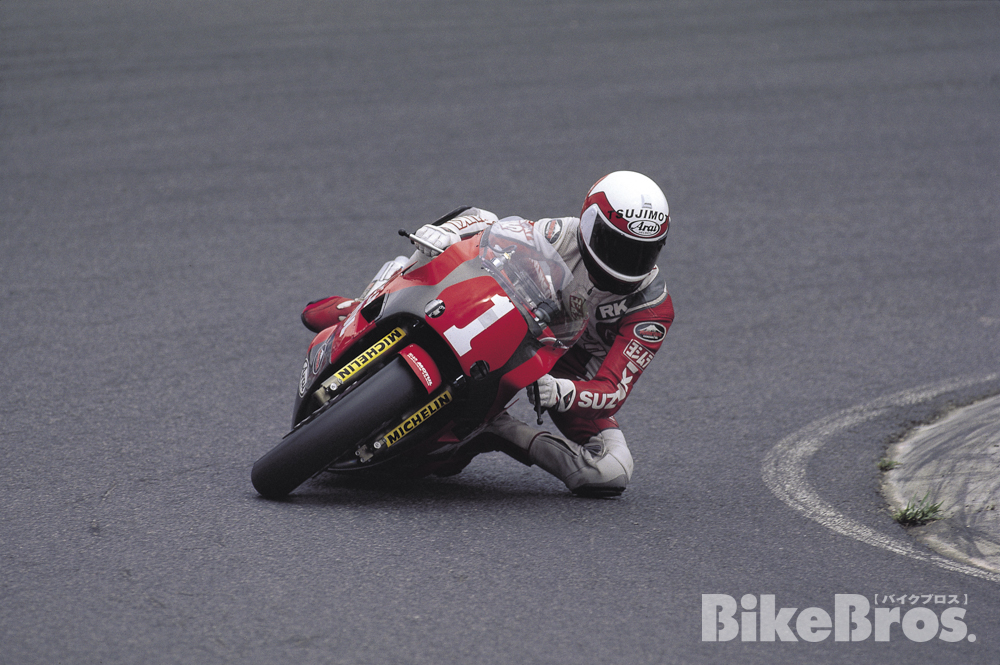
Tsujimoto at the 1986 All-Japan TT-F1 wearing the Champion’s #1. After returning from Daytona, he was surprisingly pleased with his TT-F3 bike (Yoshimura Suzuki GSX-R400), saying, “I like the way it goes into the corners. It enters the corners like a charm, so I can easily make turns. Of course, it doesn’t change the fact that TT-F1 is just as fun.” Tsujimoto’s overwhelming dominance carried him through the All-Japan series.
Yoshimura History #23: Tsujimoto’s Leap and Schwantz’s Ordeal
1986 The Wild Ones
After the 1986 Daytona 200, Satoshi Tsujimoto returned to All-Japan Road Race Championship series. He missed the opening round of the 1986 All-Japan season on March 9 (the Suzuka Big 2&4 Race, consist of TT-F1, GP500 and Japanese Formula 2 car race) in order to participate in the Daytona event held on the same day, but at the All-Japan Round 3 at Sugo on April 6 (the 2nd round for TT-F1 and the 1st for TT-F3) he went pole-to-win in both the TT-F1 and TT-F3 classes. In addition, Yoshimura newcomer Shoji Miyazaki finished in 2nd place. Tsujimoto, who has made progress through his experience at the Daytona 200, dominated the others. As if no one was there, Tsujimoto raced his way through the “All Japan” with full-throttle and power-slides, as he battled with his invisible rivals to reach even greater heights.
But on April 20, during the TT-F3 qualifying session for the All-Japan Round 4 at Suzuka, Tsujimoto crashed after trying to counter-steer out of the slide on the reverse banking. It was later revealed that the suspension and chassis of the Yoshimura Suzuki GSX-R400 could not withstand his aggressive riding style. Tsujimoto broke his left ankle in the crash and missed both TT-F3 and TT-F1 races.
“If I hadn’t crashed, I could have done 2:22 for sure,” Tsujimoto regretted.
The 2:23.295 that Tsujimoto set before his fall was the pole position time, 0.349 seconds ahead of the 2nd-place finisher (Honda RVF400), and the equivalent of the second fastest lap time in GP250 (the GP250 pole position time was Yamaha YZR250’s 2:22.568).
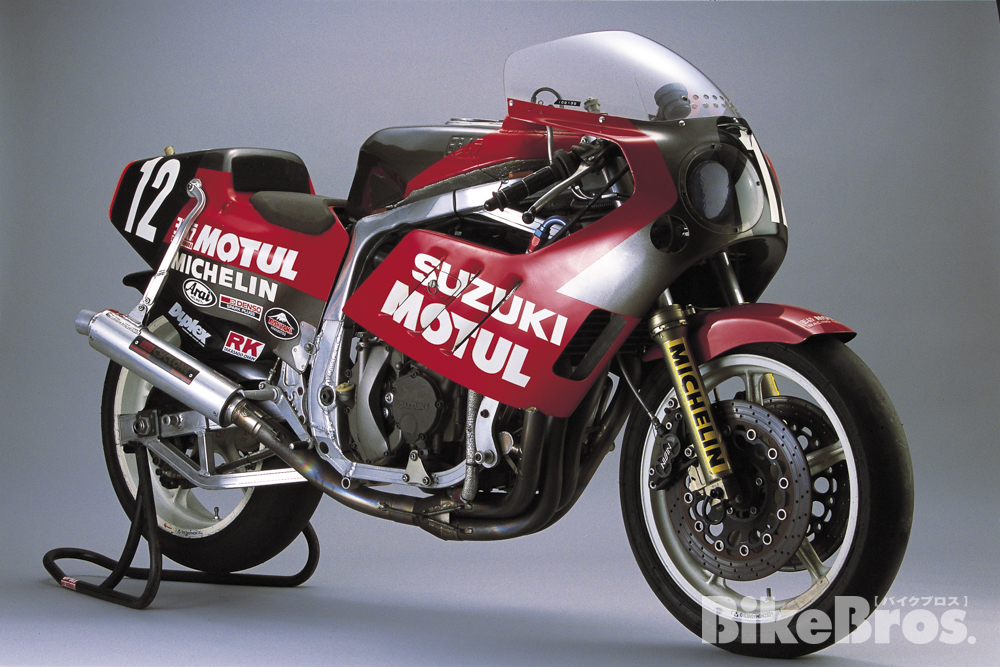
The Suzuka 8 Hours spec Yoshimura Suzuki GSX-R750 TT-F1. The half fairing was specially designed with no fastening points or offsets to accommodate lower fairing. The exhaust pipes are made of titanium and the silencer is aluminum. For the 1986 TT-F1, the characteristic chambers on the Duplex Cyclone system were relocated from the front to the back of the exhaust pipes. The carbs were 38mm magnesium Mikuni TM’s (flat slide with push/pull throttle) which were larger than the 36mm’s fitted to the Daytona-spec GSX-R750. The tires on both front and rear are 17-inch Michelin radials (12/60 on the front, 18/67 on the rear).
Tsujimoto also missed the Round 6 at Sugo (the 4th round for the TT-F1), but his new teammate Yukiya Oshima who just joined Yoshimura in 1986 went pole-to-win in TT-F1. It was Oshima’s first win in All-Japan Class A. 2nd place went to Miyazaki, making it the second 1-2 finish for Yoshimura in the 1986 season.
Tsujimoto returned to action in the TT-F1 class in Round 7 “Suzuka 200km”. His left ankle was not fully recovered and did not flex sufficiently, so his bike was fitted with a heel-toe shifter (like on the cruiser and business bikes) and a small add-on fairing to cover his left toe that could not be fully tucked behind the fairing. Tsujimoto qualified 3rd. Miyazaki took pole position. Oshima was 5th. Yoshimura’s first 3-bike team seemed to have succeeded.
But right before the final, Miyazaki fell during a warm-up run, and was unable to run in the final race, wasting his pole position advantage. Then, on Lap 16, Oshima crashed on the Spoon Curve and retired from the race.
Team Yoshimura’s hopes were pinned on Tsujimoto. Tsujimoto passed the leader Hikaru Miyagi (Moriwaki Honda CBX750) on Lap 22, and gradually pulled away to win the 34-lap race. The difference between the two was physical fitness and the choice of tires. Tsujimoto’s physical strength was not quite at his best in the comeback race, but his rehabilitation allowed him to concentrate on his training, which paid off for him and the team. As for the tires, Tsujimoto was running radials (Michelin) and Miyagi was running bias plies (Dunlop), and the radials were perfectly suited for the long race with high track temperatures. All things considered, it was good that Tsujimoto was able to test himself in a long 200km race before the Suzuka 8 Hours.
In the following round at Tsukuba, Tsujimoto took pole position in the qualifying with Oshima in 2nd, and the two finished 1-2 in the final. There was no match for Tsujimoto and the Yoshimura Suzuki GSX-R750 in All-Japan. In the Suzuka 8 Hours, however, a surprising turn of events awaited them.
In the Suzuka 8 Hours –––– 1986 FIM Endurance World Championship Round 3 –––– on July 27, Tsujimoto / Kevin Schwantz rode the #12, and Oshima / Miyazaki rode the #30. Their GSX-R750’s were equipped with an updated version of Duplex Cyclone exhaust system. Unlike the configuration at the time when they entered the Daytona 200 (AMA Superbike-spec), the position of the exhaust chambers –––– connecting pipes #1 to #2 and pipes #3 to #4 –––– were relocated from the front to the back of the exhaust pipes.
The connecting rods, which were an issue at Daytona 200, were changed from Suzuki Racing Kit rods to Carrillo H-beam rods after Daytona for both AMA and All-Japan (including Suzuka 8 Hours) spec Yoshimura Suzuki GSX-R750’s. The oil cooler was enlarged. The Suzuka 8 Hours version wore a half fairing instead of a full fairing to protect the rider from the scorching heat. Tsujimoto’s left ankle was not fully healed, and he continued to use a heel-toe shifter.
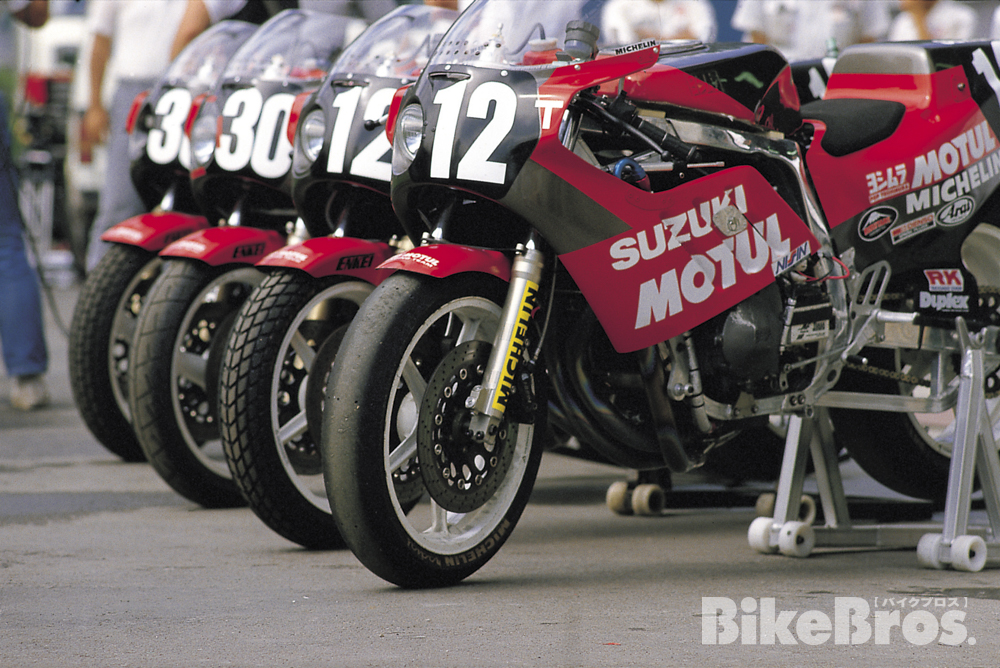
Yoshimura prepared four GSX-R750’s for the 1986 Suzuka 8 Hours. #12 and #12T are for Tsujimoto / Schwantz. #30 and #30T are for Oshima / Miyazaki. Note that the slick, rain (2 types) and intermediate tires on their fronts are for transport.
#12 Tsujimoto / Schwantz qualified 6th with a time of 2:21.840, set by Tsujimoto. Pole position went to Wayne Gardner (on Honda RVF750 with Dominique Sarron) at 2:18.923, with Kenny Roberts (on Yamaha YZF750 with Mike Baldwin) 2nd at 2:20.190. Tsujimoto was the second fastest Japanese behind Tadahiko Taira (on Yamaha YZF750 with Christian Sarron) at 2:21.839. It was more frustrating that he could not catch up with Gardner, Roberts, C. Sarron, Kevin Magee (on Yamaha FZ750 with Michael Dawson) and Malcolm Campbell (on Honda RVF750 with Keiji Kinoshita) than that he was 0.001 seconds short of Taira. In qualifying, he marked Gardner and Roberts, and if either of them came out of the pits, Tsujimoto was thorough in his pursuit.
However, it was not only that the water-cooled rivals were faster, but also the fact that the air-and-oil-cooled GSX-R750 was losing power due to heat sag caused by the midsummer heat of Suzuka. The problem of heat sagging had been evident since the 1985 Suzuka 8 Hours, but it became more serious in 1986, and from then on, the oil-cooled machines had to battle against the heat.
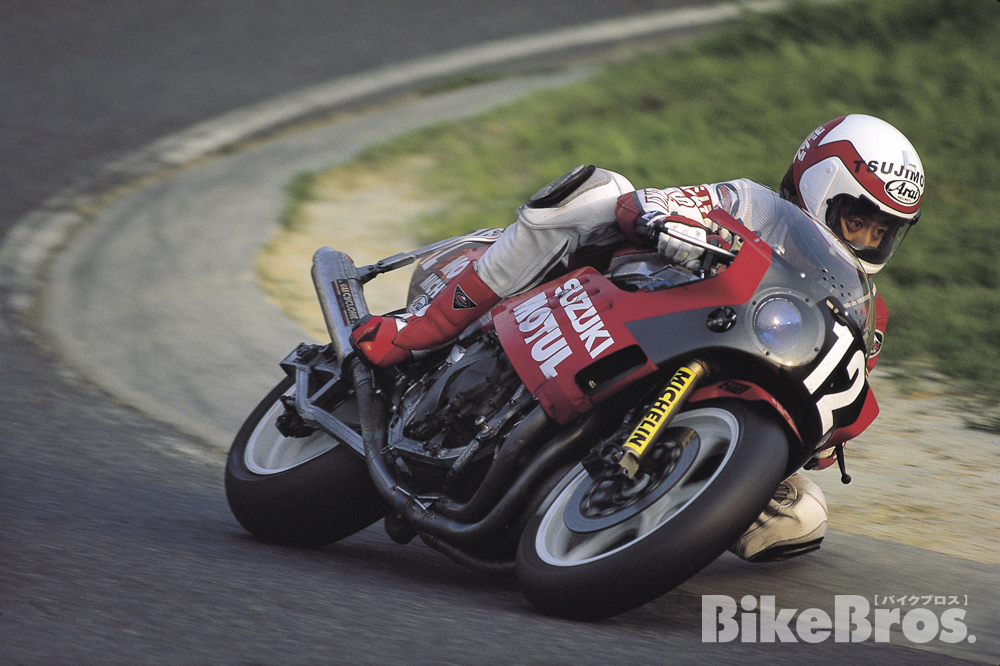
In the qualifying, Tsujimoto tried to follow Gardner, but Gardner did not push his bike hard when Tsujimoto was behind him. Grand Prix riders are tough, and they don’t show their hands to their opponents. This means that Gardner recognized Tsujimoto as a rival. In the final, Gardner and Christian Sarron had a quiet but very high-level battle. Sarron seemed to be able to overtake, but he couldn’t. The GP riders were able to ride with high precision. “If Tsujimoto and the GSX-R750 are in their current state, we have a good chance against GP riders and factory machines,” Fujio said.
Before Sunday’s Suzuka 8 Hours final, Pop and the Yoshimura staff had a pleasant surprise at the Suzuka 4 Hours race on Saturday. Katsuro Takayoshi and Hitoshi Ishigami of RT Mirage Kanto, a local racing team supported by Yoshimura, won the race. Pop personally welcomed them with joy.
In the final race of the Suzuka 8 Hours, Gardner / D. Sarron showed exceptional speed and took the lead, with Roberts / Baldwin, Taira / C. Sarron, and Tsujimoto / Schwantz battling it out for 2nd place. Then on Lap 37, Schwantz suddenly came in for a pit stop after 1 hour and 30 minutes of his first stint. The shifter linkage on the #12 bike was broken. It had never been broken in All-Japan, but the heel-toe shifter may have been the cause of the failure. After spending about 5 minutes to replace it, the #12 was down 2 laps from the leader and dropped to 21st place.
This was not the only unexpected turn of events: Taira / C. Sarron retired on Lap 103, and Roberts / Baldwin retired on Lap 130. It was a self-defeat for the Yamaha factory team, which was favorite to win the race. With this, the top position remained unchanged with Gardner / D. Sarron, but Dawson / Magee moved up to 2nd, followed by Tsujimoto / Schwantz, who steadily moved up the order.
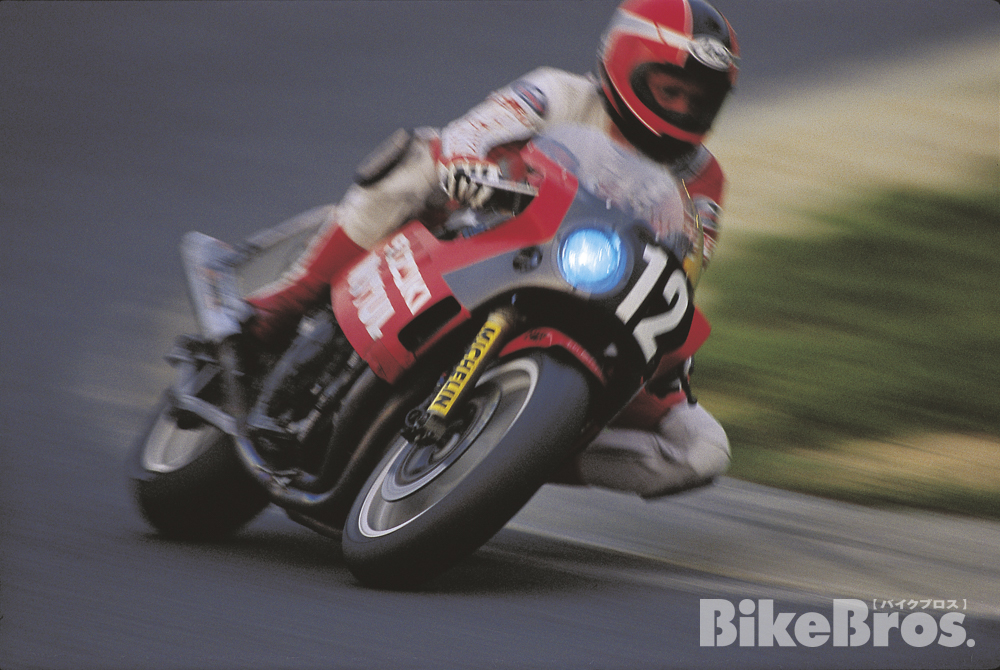
Schwantz’s pace didn’t pick up even after the headlight was on. At the end of the 8 hours (7:30 p.m.), he unfortunately took the checkered flag ahead of Dawson / Magee of Australian Marlboro Yamaha Dealer Team, who placed 2nd with 195 laps (in 8 hours, 01 minutes, 57.584 seconds). #12 Team Yoshimura was 1 lap down from them, placing 3rd with 194 laps (in 8 hours 00 minutes, 07.246 seconds). The winning Team HRC had 197 laps. The single asymmetric headlight on the right-hand side of the Suzuka 8 Hours-spec Yoshimura Suzuki GSX-R750 was changed to blue in 1986.
With just under 2 hours remaining, the #12 rider changed from Schwantz to Tsujimoto, who in 3rd place began to close the gap to 2nd place Magee by about 3 seconds per lap. At this pace he could turn the tables, but after he was replaced by Schwantz about an hour later, the gap was no longer closing. Schwantz was exhausted by the final phase of the race. In the first place, Schwantz had been lackluster since the start of the Suzuka 8 Hours week, and it was clear that he was lacking in fitness. Meanwhile, Tsujimoto was in the process of rehabilitating from his left ankle injury and had been putting more effort into his training, and his physical and mental condition was better than before. Pop was yelling, “Let Tsujimoto ride all the way to the finish!” and the staff was having a hard time appeasing Pop.
Tsujimoto / Schwantz finished 3rd in the end, however, this was the second year in a row that Schwantz was on the podium, following the 3rd place finish (with Graeme Crosby) in 1985. Tsujimoto never forgot the view from the podium; the spectators filling the racetrack, the huge grandstands…. “Next time,” Tsujimoto swore to himself, “I’ll definitely see this view from the highest place!”
After the Suzuka 8 Hours, Tsujimoto won three consecutive TT-F1 rounds (Round 9 at Tsukuba, Round 10 at Sugo, and the final round “Japanese Grand Prix” at Suzuka), and was crowned All-Japan TT-F1 champion for the second year in a row.
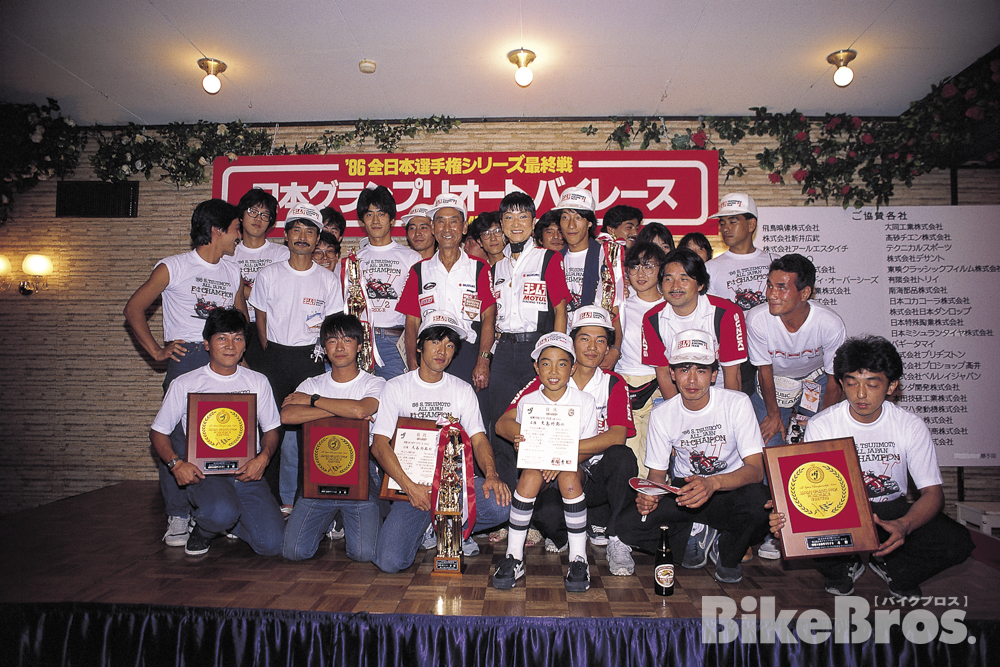
Commemorative photo taken at the formal awards ceremony, following the final round –––– then titled “Japanese Grand Prix” –––– of the 1986 All-Japan Road Race Championship at Suzuka, on September 14. The awards ceremony at that time was held at the Suzuka Circuit Hotel, separately from the podium ceremony. In the back row, third from the left is Fujio; partially visible behind his left shoulder is Mechanic Okamoto; to his right are Tsujimoto wearing a “TT-F1 All-Japan V2” T-shirt and holding a trophy (13th in TT-F3 ranking); Mechanic Takenaka; Pop with a big smile; and Managing Director Yumiko Kato. In the front row from left to right are: Chief Mechanic Asakawa; Miyazaki (11th in TT-F1 ranking, 5th in TT-F3 ranking); Oshima (2nd in TT-F1 ranking, 9th in TT-F3 ranking); and the boy sitting on the lap of Mechanic Konno is little Yohei Kato, the future Team Yoshimura Director, who is about to turn 11 in November.
Schwantz, meanwhile, had a season of gaining experience to make a leap forward. First, he made his European debut at the non-championship “Race of the Year” held at Mallory Park circuit in England on April 19 and 20. Senior Suzuki rider and the 1976-1977 GP500 World Champion Barry Sheene prepared the bike for him (1986 Suzuki RG500Γ square-four engine mounted on a steel Harris frame ridden by Sheene himself in 1984). Schwantz finished in 2nd place on both days, a great achievement. He also entered the GP500 World Championship and raced in the Dutch TT (as well as in TT-F1 with the RG500Γ), the Belgian GP (scored his first GP points with a 10th-place finish) and the San Marino GP. Both Sheene and Suzuki were expecting Schwantz to be the next ace for GP500. In AMA Superbike, however, he finished the 1986 season without a win and in 7th place in the standings, even though he had an oil-cooled GSX-R750.
The 1986 season thus came to an end, and the highly anticipated 1987 season was about to begin for the two riders.
============================================================
Published on February 13, 2023
Stories and photos supplied by Yoshimura Japan / Takao Isobe
Written by Tomoya Ishibashi
Edited by Bike Bros Magazines
